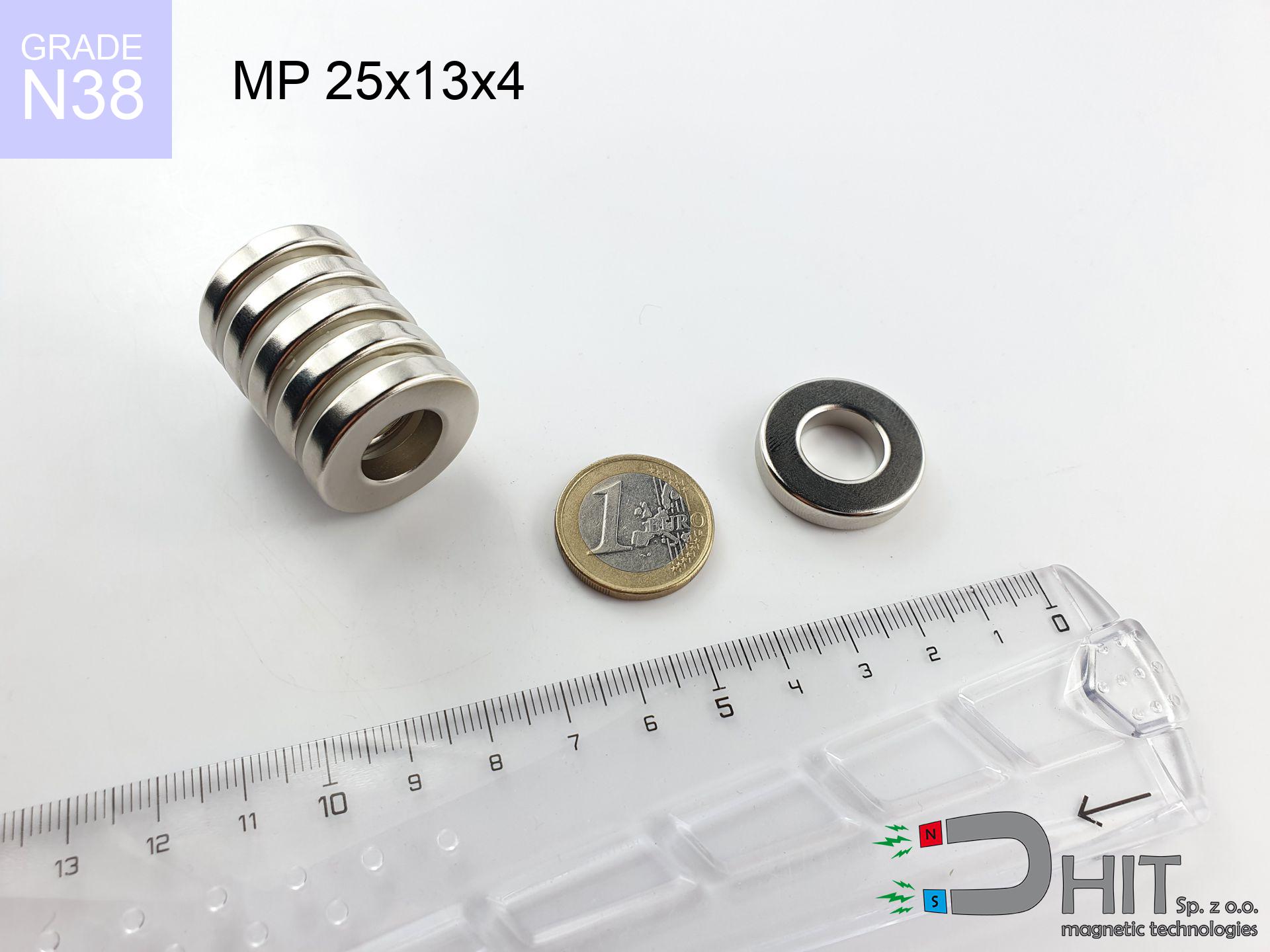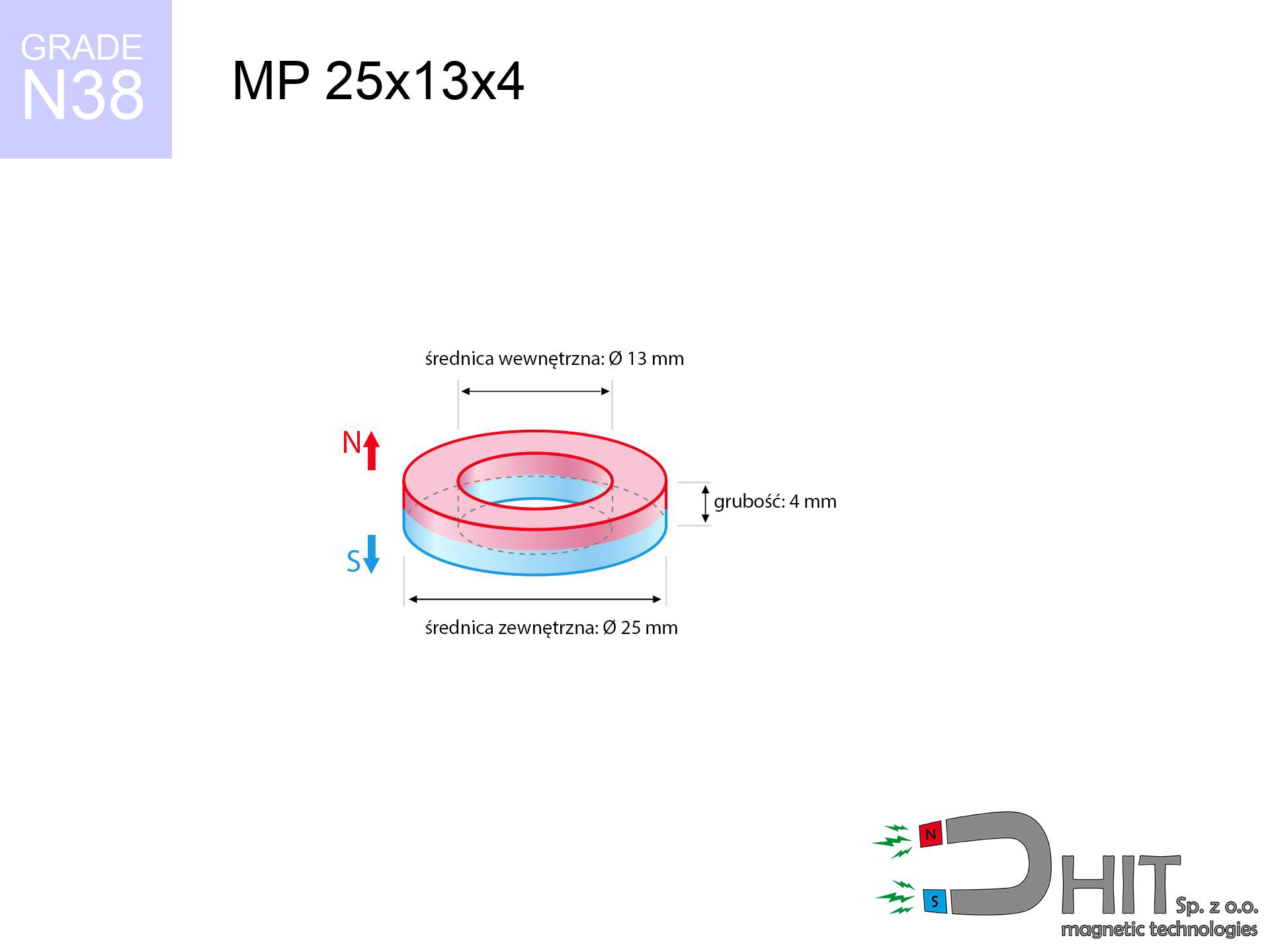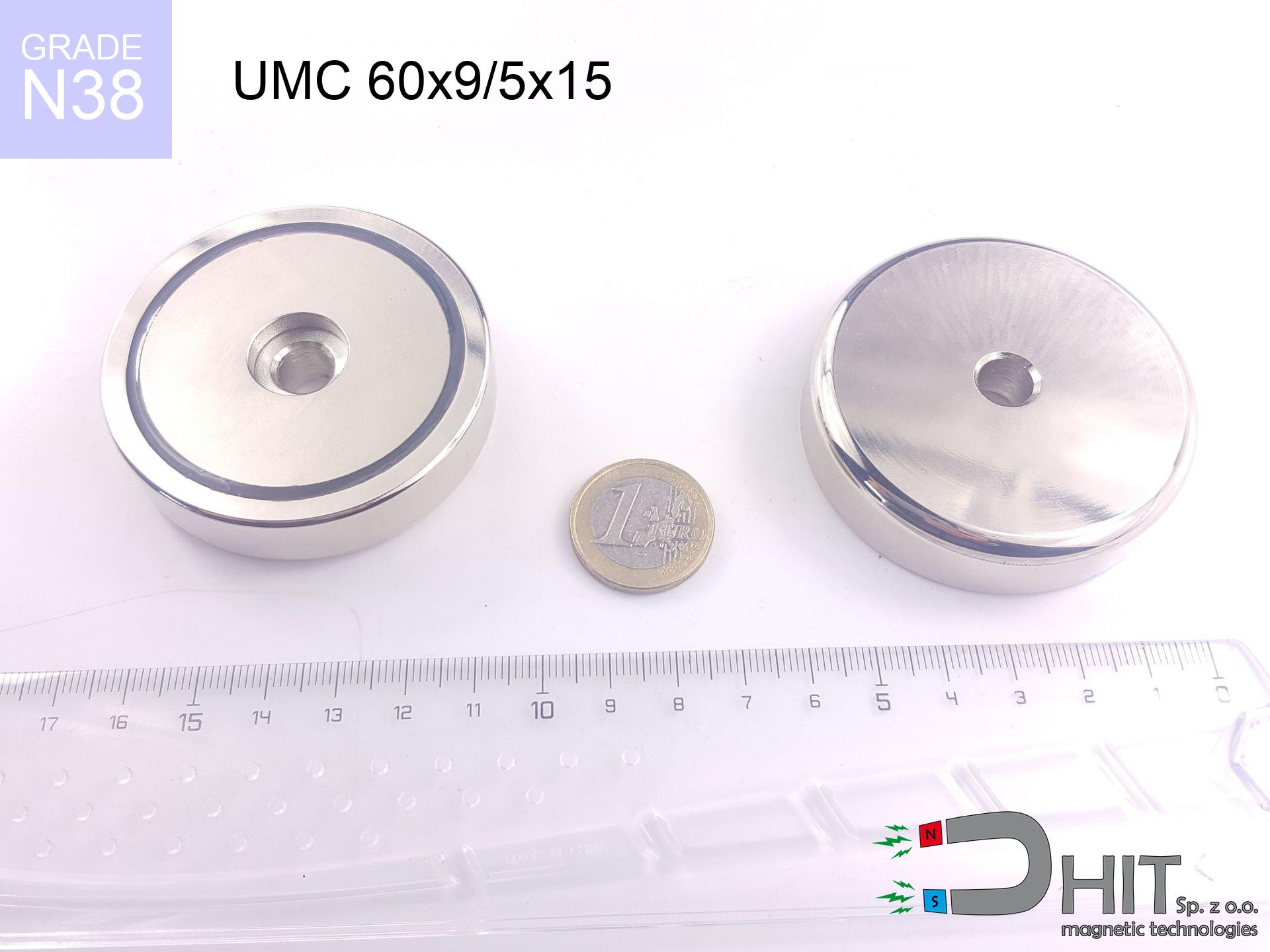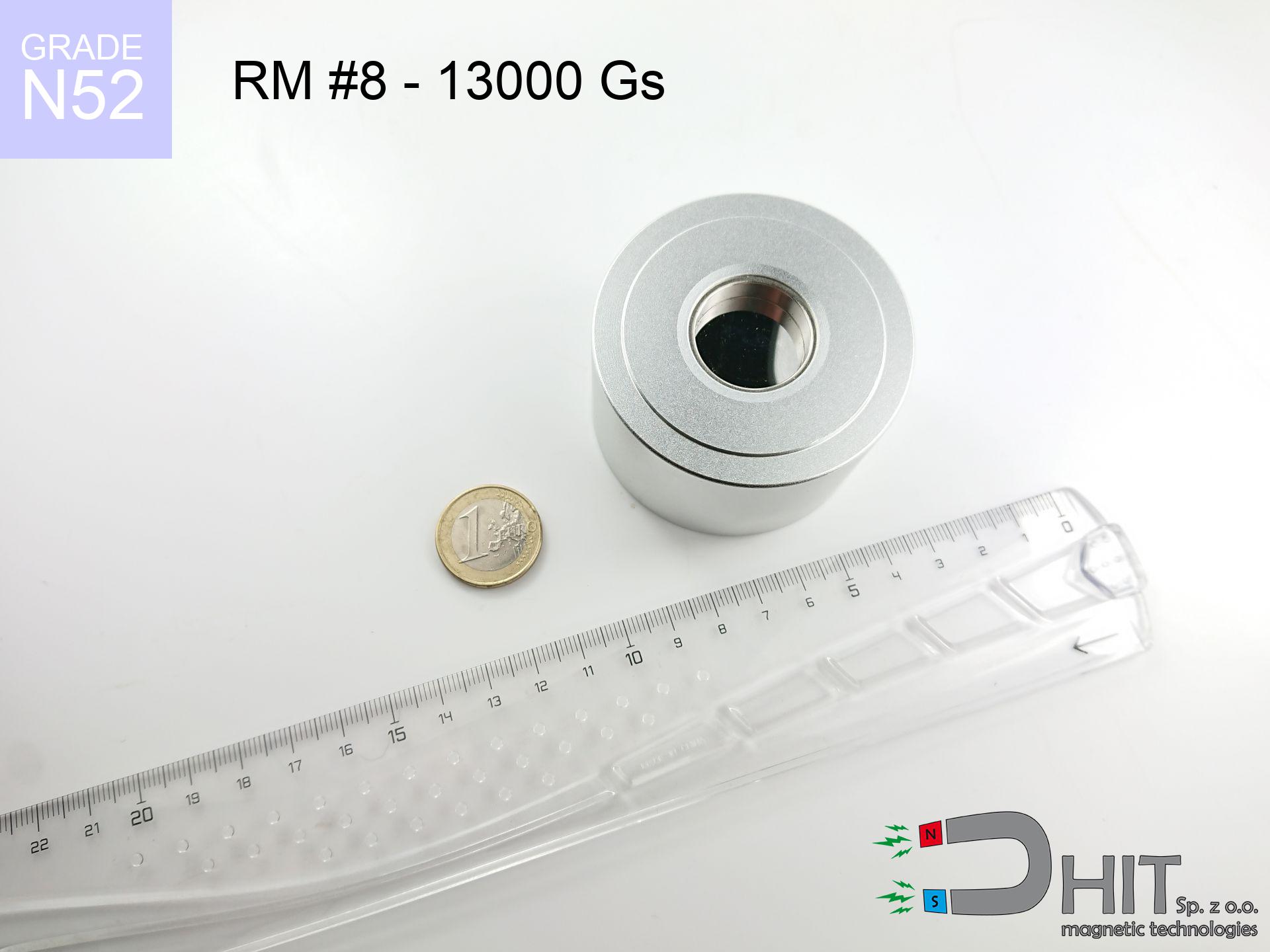MP 25x13x4 / N38 - ring magnet
ring magnet
Catalog no 030190
GTIN/EAN: 5906301812074
Diameter
25 mm [±0,1 mm]
internal diameter Ø
13 mm [±0,1 mm]
Height
4 mm [±0,1 mm]
Weight
10.74 g
Magnetization Direction
↑ axial
Load capacity
4.14 kg / 40.57 N
Magnetic Induction
188.92 mT / 1889 Gs
Coating
[NiCuNi] Nickel
6.77 ZŁ with VAT / pcs + price for transport
5.50 ZŁ net + 23% VAT / pcs
bulk discounts:
Need more?
Call us now
+48 22 499 98 98
or send us a note via
request form
the contact page.
Strength as well as form of a magnet can be checked on our
force calculator.
Order by 14:00 and we’ll ship today!
Physical properties - MP 25x13x4 / N38 - ring magnet
Specification / characteristics - MP 25x13x4 / N38 - ring magnet
| properties | values |
|---|---|
| Cat. no. | 030190 |
| GTIN/EAN | 5906301812074 |
| Production/Distribution | Dhit sp. z o.o. |
| Country of origin | Poland / China / Germany |
| Customs code | 85059029 |
| Diameter | 25 mm [±0,1 mm] |
| internal diameter Ø | 13 mm [±0,1 mm] |
| Height | 4 mm [±0,1 mm] |
| Weight | 10.74 g |
| Magnetization Direction | ↑ axial |
| Load capacity ~ ? | 4.14 kg / 40.57 N |
| Magnetic Induction ~ ? | 188.92 mT / 1889 Gs |
| Coating | [NiCuNi] Nickel |
| Manufacturing Tolerance | ±0.1 mm |
Magnetic properties of material N38
| properties | values | units |
|---|---|---|
| remenance Br [min. - max.] ? | 12.2-12.6 | kGs |
| remenance Br [min. - max.] ? | 1220-1260 | mT |
| coercivity bHc ? | 10.8-11.5 | kOe |
| coercivity bHc ? | 860-915 | kA/m |
| actual internal force iHc | ≥ 12 | kOe |
| actual internal force iHc | ≥ 955 | kA/m |
| energy density [min. - max.] ? | 36-38 | BH max MGOe |
| energy density [min. - max.] ? | 287-303 | BH max KJ/m |
| max. temperature ? | ≤ 80 | °C |
Physical properties of sintered neodymium magnets Nd2Fe14B at 20°C
| properties | values | units |
|---|---|---|
| Vickers hardness | ≥550 | Hv |
| Density | ≥7.4 | g/cm3 |
| Curie Temperature TC | 312 - 380 | °C |
| Curie Temperature TF | 593 - 716 | °F |
| Specific resistance | 150 | μΩ⋅cm |
| Bending strength | 250 | MPa |
| Compressive strength | 1000~1100 | MPa |
| Thermal expansion parallel (∥) to orientation (M) | (3-4) x 10-6 | °C-1 |
| Thermal expansion perpendicular (⊥) to orientation (M) | -(1-3) x 10-6 | °C-1 |
| Young's modulus | 1.7 x 104 | kg/mm² |
Technical simulation of the assembly - data
These data represent the outcome of a physical analysis. Results are based on models for the class Nd2Fe14B. Actual conditions might slightly differ. Use these data as a reference point for designers.
Table 1: Static force (force vs distance) - interaction chart
MP 25x13x4 / N38
| Distance (mm) | Induction (Gauss) / mT | Pull Force (kg) | Risk Status |
|---|---|---|---|
| 0 mm |
5777 Gs
577.7 mT
|
4.14 kg / 4140.0 g
40.6 N
|
medium risk |
| 1 mm |
5310 Gs
531.0 mT
|
3.50 kg / 3497.4 g
34.3 N
|
medium risk |
| 2 mm |
4846 Gs
484.6 mT
|
2.91 kg / 2912.4 g
28.6 N
|
medium risk |
| 3 mm |
4397 Gs
439.7 mT
|
2.40 kg / 2398.5 g
23.5 N
|
medium risk |
| 5 mm |
3576 Gs
357.6 mT
|
1.59 kg / 1586.2 g
15.6 N
|
low risk |
| 10 mm |
2073 Gs
207.3 mT
|
0.53 kg / 532.9 g
5.2 N
|
low risk |
| 15 mm |
1231 Gs
123.1 mT
|
0.19 kg / 188.0 g
1.8 N
|
low risk |
| 20 mm |
773 Gs
77.3 mT
|
0.07 kg / 74.0 g
0.7 N
|
low risk |
| 30 mm |
356 Gs
35.6 mT
|
0.02 kg / 15.7 g
0.2 N
|
low risk |
| 50 mm |
115 Gs
11.5 mT
|
0.00 kg / 1.6 g
0.0 N
|
low risk |
Table 2: Shear hold (wall)
MP 25x13x4 / N38
| Distance (mm) | Friction coefficient | Pull Force (kg) |
|---|---|---|
| 0 mm | Stal (~0.2) |
0.83 kg / 828.0 g
8.1 N
|
| 1 mm | Stal (~0.2) |
0.70 kg / 700.0 g
6.9 N
|
| 2 mm | Stal (~0.2) |
0.58 kg / 582.0 g
5.7 N
|
| 3 mm | Stal (~0.2) |
0.48 kg / 480.0 g
4.7 N
|
| 5 mm | Stal (~0.2) |
0.32 kg / 318.0 g
3.1 N
|
| 10 mm | Stal (~0.2) |
0.11 kg / 106.0 g
1.0 N
|
| 15 mm | Stal (~0.2) |
0.04 kg / 38.0 g
0.4 N
|
| 20 mm | Stal (~0.2) |
0.01 kg / 14.0 g
0.1 N
|
| 30 mm | Stal (~0.2) |
0.00 kg / 4.0 g
0.0 N
|
| 50 mm | Stal (~0.2) |
0.00 kg / 0.0 g
0.0 N
|
Table 3: Vertical assembly (shearing) - vertical pull
MP 25x13x4 / N38
| Surface type | Friction coefficient / % Mocy | Max load (kg) |
|---|---|---|
| Raw steel |
µ = 0.3
30% Nominalnej Siły
|
1.24 kg / 1242.0 g
12.2 N
|
| Painted steel (standard) |
µ = 0.2
20% Nominalnej Siły
|
0.83 kg / 828.0 g
8.1 N
|
| Oily/slippery steel |
µ = 0.1
10% Nominalnej Siły
|
0.41 kg / 414.0 g
4.1 N
|
| Magnet with anti-slip rubber |
µ = 0.5
50% Nominalnej Siły
|
2.07 kg / 2070.0 g
20.3 N
|
Table 4: Steel thickness (saturation) - power losses
MP 25x13x4 / N38
| Steel thickness (mm) | % power | Real pull force (kg) |
|---|---|---|
| 0.5 mm |
|
0.41 kg / 414.0 g
4.1 N
|
| 1 mm |
|
1.04 kg / 1035.0 g
10.2 N
|
| 2 mm |
|
2.07 kg / 2070.0 g
20.3 N
|
| 5 mm |
|
4.14 kg / 4140.0 g
40.6 N
|
| 10 mm |
|
4.14 kg / 4140.0 g
40.6 N
|
Table 5: Working in heat (material behavior) - resistance threshold
MP 25x13x4 / N38
| Ambient temp. (°C) | Power loss | Remaining pull | Status |
|---|---|---|---|
| 20 °C | 0.0% |
4.14 kg / 4140.0 g
40.6 N
|
OK |
| 40 °C | -2.2% |
4.05 kg / 4048.9 g
39.7 N
|
OK |
| 60 °C | -4.4% |
3.96 kg / 3957.8 g
38.8 N
|
OK |
| 80 °C | -6.6% |
3.87 kg / 3866.8 g
37.9 N
|
|
| 100 °C | -28.8% |
2.95 kg / 2947.7 g
28.9 N
|
Table 6: Magnet-Magnet interaction (attraction) - field collision
MP 25x13x4 / N38
| Gap (mm) | Attraction (kg) (N-S) | Repulsion (kg) (N-N) |
|---|---|---|
| 0 mm |
83.66 kg / 83661 g
820.7 N
6 082 Gs
|
N/A |
| 1 mm |
77.09 kg / 77087 g
756.2 N
11 091 Gs
|
69.38 kg / 69378 g
680.6 N
~0 Gs
|
| 2 mm |
70.68 kg / 70675 g
693.3 N
10 620 Gs
|
63.61 kg / 63608 g
624.0 N
~0 Gs
|
| 3 mm |
64.59 kg / 64591 g
633.6 N
10 153 Gs
|
58.13 kg / 58131 g
570.3 N
~0 Gs
|
| 5 mm |
53.48 kg / 53478 g
524.6 N
9 238 Gs
|
48.13 kg / 48130 g
472.2 N
~0 Gs
|
| 10 mm |
32.05 kg / 32053 g
314.4 N
7 152 Gs
|
28.85 kg / 28848 g
283.0 N
~0 Gs
|
| 20 mm |
10.77 kg / 10768 g
105.6 N
4 145 Gs
|
9.69 kg / 9691 g
95.1 N
~0 Gs
|
| 50 mm |
0.66 kg / 657 g
6.4 N
1 024 Gs
|
0.59 kg / 592 g
5.8 N
~0 Gs
|
Table 7: Hazards (implants) - warnings
MP 25x13x4 / N38
| Object / Device | Limit (Gauss) / mT | Safe distance |
|---|---|---|
| Pacemaker | 5 Gs (0.5 mT) | 17.0 cm |
| Hearing aid | 10 Gs (1.0 mT) | 13.5 cm |
| Mechanical watch | 20 Gs (2.0 mT) | 10.5 cm |
| Mobile device | 40 Gs (4.0 mT) | 8.0 cm |
| Car key | 50 Gs (5.0 mT) | 7.5 cm |
| Payment card | 400 Gs (40.0 mT) | 3.0 cm |
| HDD hard drive | 600 Gs (60.0 mT) | 2.5 cm |
Table 8: Impact energy (kinetic energy) - collision effects
MP 25x13x4 / N38
| Start from (mm) | Speed (km/h) | Energy (J) | Predicted outcome |
|---|---|---|---|
| 10 mm |
21.33 km/h
(5.93 m/s)
|
0.19 J | |
| 30 mm |
34.38 km/h
(9.55 m/s)
|
0.49 J | |
| 50 mm |
44.29 km/h
(12.30 m/s)
|
0.81 J | |
| 100 mm |
62.62 km/h
(17.39 m/s)
|
1.62 J |
Table 9: Anti-corrosion coating durability
MP 25x13x4 / N38
| Technical parameter | Value / Description |
|---|---|
| Coating type | [NiCuNi] Nickel |
| Layer structure | Nickel - Copper - Nickel |
| Layer thickness | 10-20 µm |
| Salt spray test (SST) ? | 24 h |
| Recommended environment | Indoors only (dry) |
Table 10: Electrical data (Pc)
MP 25x13x4 / N38
| Parameter | Value | SI Unit / Description |
|---|---|---|
| Magnetic Flux | 24 861 Mx | 248.6 µWb |
| Pc Coefficient | 1.02 | High (Stable) |
Table 11: Physics of underwater searching
MP 25x13x4 / N38
| Environment | Effective steel pull | Effect |
|---|---|---|
| Air (land) | 4.14 kg | Standard |
| Water (riverbed) |
4.74 kg
(+0.60 kg Buoyancy gain)
|
+14.5% |
1. Vertical hold
*Note: On a vertical wall, the magnet retains just approx. 20-30% of its nominal pull.
2. Efficiency vs thickness
*Thin steel (e.g. computer case) significantly weakens the holding force.
3. Thermal stability
*For N38 material, the safety limit is 80°C.
4. Demagnetization curve and operating point (B-H)
chart generated for the permeance coefficient Pc (Permeance Coefficient) = 1.02
This simulation demonstrates the magnetic stability of the selected magnet under specific geometric conditions. The solid red line represents the demagnetization curve (material potential), while the dashed blue line is the load line based on the magnet's geometry. The Pc (Permeance Coefficient), also known as the load line slope, is a dimensionless value that describes the relationship between the magnet's shape and its magnetic stability. The intersection of these two lines (the black dot) is the operating point — it determines the actual magnetic flux density generated by the magnet in this specific configuration. A higher Pc value means the magnet is more 'slender' (tall relative to its area), resulting in a higher operating point and better resistance to irreversible demagnetization caused by external fields or temperature. A value of 0.42 is relatively low (typical for flat magnets), meaning the operating point is closer to the 'knee' of the curve — caution is advised when operating at temperatures near the maximum limit to avoid strength loss.
Material specification
| iron (Fe) | 64% – 68% |
| neodymium (Nd) | 29% – 32% |
| boron (B) | 1.1% – 1.2% |
| dysprosium (Dy) | 0.5% – 2.0% |
| coating (Ni-Cu-Ni) | < 0.05% |
Ecology and recycling (GPSR)
| recyclability (EoL) | 100% |
| recycled raw materials | ~10% (pre-cons) |
| carbon footprint | low / zredukowany |
| waste code (EWC) | 16 02 16 |
Other products
Advantages as well as disadvantages of neodymium magnets.
Advantages
- They retain magnetic properties for almost ten years – the drop is just ~1% (according to analyses),
- They maintain their magnetic properties even under close interference source,
- In other words, due to the metallic layer of gold, the element becomes visually attractive,
- Magnets are characterized by excellent magnetic induction on the active area,
- Neodymium magnets are characterized by extremely high magnetic induction on the magnet surface and are able to act (depending on the form) even at a temperature of 230°C or more...
- Thanks to modularity in designing and the capacity to adapt to client solutions,
- Huge importance in electronics industry – they find application in computer drives, drive modules, diagnostic systems, also technologically advanced constructions.
- Compactness – despite small sizes they offer powerful magnetic field, making them ideal for precision applications
Cons
- At very strong impacts they can crack, therefore we advise placing them in special holders. A metal housing provides additional protection against damage and increases the magnet's durability.
- We warn that neodymium magnets can reduce their power at high temperatures. To prevent this, we recommend our specialized [AH] magnets, which work effectively even at 230°C.
- They rust in a humid environment - during use outdoors we advise using waterproof magnets e.g. in rubber, plastic
- We recommend casing - magnetic mount, due to difficulties in creating nuts inside the magnet and complex shapes.
- Health risk related to microscopic parts of magnets pose a threat, in case of ingestion, which becomes key in the context of child health protection. Additionally, tiny parts of these products are able to be problematic in diagnostics medical after entering the body.
- High unit price – neodymium magnets are more expensive than other types of magnets (e.g. ferrite), which can limit application in large quantities
Pull force analysis
Detachment force of the magnet in optimal conditions – what contributes to it?
- on a block made of mild steel, perfectly concentrating the magnetic flux
- with a thickness of at least 10 mm
- with a surface free of scratches
- without the slightest clearance between the magnet and steel
- under axial force direction (90-degree angle)
- in temp. approx. 20°C
Practical aspects of lifting capacity – factors
- Space between magnet and steel – every millimeter of distance (caused e.g. by varnish or unevenness) diminishes the magnet efficiency, often by half at just 0.5 mm.
- Direction of force – highest force is available only during pulling at a 90° angle. The resistance to sliding of the magnet along the surface is typically many times smaller (approx. 1/5 of the lifting capacity).
- Wall thickness – the thinner the sheet, the weaker the hold. Part of the magnetic field passes through the material instead of converting into lifting capacity.
- Steel type – low-carbon steel gives the best results. Alloy admixtures lower magnetic permeability and holding force.
- Surface finish – full contact is obtained only on polished steel. Rough texture create air cushions, reducing force.
- Operating temperature – NdFeB sinters have a sensitivity to temperature. At higher temperatures they lose power, and in frost gain strength (up to a certain limit).
Lifting capacity testing was carried out on plates with a smooth surface of suitable thickness, under a perpendicular pulling force, however under shearing force the load capacity is reduced by as much as 75%. In addition, even a slight gap between the magnet and the plate decreases the lifting capacity.
Safety rules for work with neodymium magnets
Choking Hazard
Only for adults. Tiny parts can be swallowed, leading to severe trauma. Keep away from kids and pets.
Warning for allergy sufferers
Allergy Notice: The nickel-copper-nickel coating consists of nickel. If an allergic reaction occurs, cease working with magnets and wear gloves.
Heat sensitivity
Keep cool. NdFeB magnets are susceptible to heat. If you need operation above 80°C, ask us about special high-temperature series (H, SH, UH).
Risk of cracking
NdFeB magnets are sintered ceramics, which means they are very brittle. Clashing of two magnets leads to them shattering into shards.
Keep away from electronics
Navigation devices and smartphones are highly sensitive to magnetism. Close proximity with a powerful NdFeB magnet can permanently damage the internal compass in your phone.
Keep away from computers
Avoid bringing magnets close to a wallet, laptop, or TV. The magnetism can permanently damage these devices and erase data from cards.
Physical harm
Danger of trauma: The attraction force is so great that it can cause hematomas, crushing, and even bone fractures. Protective gloves are recommended.
Medical interference
Patients with a heart stimulator should maintain an absolute distance from magnets. The magnetism can interfere with the functioning of the life-saving device.
Do not underestimate power
Handle magnets with awareness. Their immense force can surprise even experienced users. Stay alert and do not underestimate their force.
Fire warning
Dust generated during grinding of magnets is self-igniting. Avoid drilling into magnets unless you are an expert.







![SM 25x300 [2xM8] / N52 - magnetic separator SM 25x300 [2xM8] / N52 - magnetic separator](https://cdn3.dhit.pl/graphics/products/sm-25x300-2xm8-dij.jpg)

